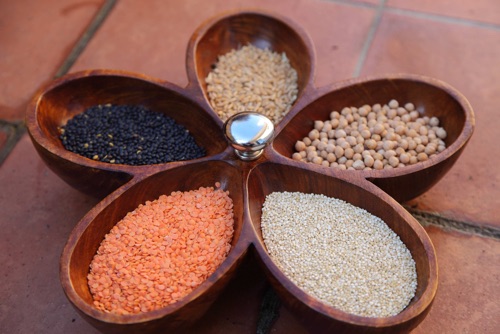News
26 November 2019
Turmoil in the world of seeds
There was a complete stalemate at the Eighth Session of the Governing Body of the International Treaty on Plant Genetic Resources for Food and Agriculture (ITPGRFA) held at FAO Headquarters in Rome, from 11 to 16 November of this year.
Financial aspects of the Treaty were the major item on the agenda of this session. The objective was to improve the “Multilateral System of Access and Benefit-sharing” and to implement this system while envisaging bringing eventual adjustments, if needed, to the Treaty itself.
The ITPGRFA Treaty
What is it exactly about?
For those of our readers who may not be familiar with the seed issue (a key factor of agriculture), let’s remind here that the International Treaty on Plant Genetic Resources for Food and Agriculture (more prosaically the International Seed Treaty or ITPGRFA) was adopted by FAO member countries in 2001. It recognises the rights of farmers on their seeds (a right that was also formally reconfirmed by the United Nations Declaration on the Rights of Peasants and Other People Working in Rural Areas of 2018).

In the words of the website dedicated to the Treaty by FAO:
“The Treaty aims at:
-
•recognizing the enormous contribution of farmers to the diversity of crops that feed the world;
-
•establishing a global system to provide farmers, plant breeders and scientists with access to plant genetic materials;
-
•ensuring that recipients share benefits they derive from the use of these genetic materials.”
From the point of view of the work done, several hundreds of gene banks were created in the framework of the Multilateral System of Access and Benefit-sharing of the Treaty. They store around 7 million samples of seeds of 64 most important crops that together account for 80 percent of all human consumption. The best known (and largest) of these gene banks is the Svalbard Global Seed Vault located on Spitsbergen Island, Norway, because of the particularly favourable conditions for preservation. Inaugurated in 2008, the Svalbard Vault held around one million seed samples by 2018. Its construction and operation, as well as the supply of seeds was funded by Norway and 16 other countries*, along with several private organisations among which the Rockefeller, Gates and Syngenta Foundations (we remind here our readers that Syngenta is one of the main agrochemical multinationals, initially Swiss but acquired by China’s ChemChina in 2017. The company’s turn over was more than $13 billion in 2018, of which $3 billion for seeds).
The access to the resources collected in the framework of the Treaty is limited to ratifying countries who have committed to use them exclusively for the purpose of research, selection and training related to food and agriculture. This use includes the production of new varieties. Users cannot claim any intellectual property right on these resources in the form received and should share benefits of using them, the objective being to use the money collected for reinforcing the protection of genetic resources throughout the world, in particular. Payments have been made from public (governments) and private (companies) sources, but the amounts have been found insufficient and too unreliable by beneficiary countries.

The problem
The objective of the Eighth Session was therefore to define modalities of sharing the benefits accrued from the use of genetic resources under the Treaty and to improve the functioning of the Multilateral System of Access and Benefit-sharing.
According to the view of La Via Campesina, a peasant movement created in 1993 grouping 182 local organisations in 81 countries and representing around 200 million peasants, the industry “has never shared the profits [it has] made… [and]… most countries do not respect farmers’ rights”.
In an article dated 2018, a group of experts in this field estimate that the benefits generated by the Treaty are not limited to the financial profits linked to the eventual use of resources. They also included the services provided and savings made because of the ease of access to resources and to information disseminated by researchers working in this area. These arguments added further justifications for revisiting the benefit-sharing mechanism.
However, discussions that took place during the Session led to a stalemate, the Treaty being thus “totally paralyzed by the greed of the biotech industry and [of] the richest countries” (La Via Campesina).
Negotiations blocked on the issue of the digital sequencing of genetic resources. This sequencing allows to link the genetic information found in plant DNA to some characteristics of this plant (e.g. adaptation to certain conditions, resistance to diseases, nutritional or organoleptic quality, aspect, etc.). This kind of result can be subject to a patent that does not require for those who file it to provide information on the origin of the genetic resources that have been sequenced (which prevents from tracing back those people with whom the benefits from the patent should be shared). Once the patent is registered, it can be applied to all plants containing the information sequenced (not only the plant initially analysed but also all plants that contain the particular sequence whether they have been obtained by cross-breeding, selection, mutation and, of course, by biotechnological engineering).
Digital sequencing of genetic resources therefore offers to those who implement it (i.e. specialised companies) the possibility to grab the ownership, with time, of all the genetic resources protected by the Treaty, which would totally jeopardise its purpose and constitute a gigantic operation of biopiracy. Indeed, once the information patented, the use of seeds containing it could be forbidden to farmers. This would be a totally absurd situation as it is thanks to the work of farmers over centuries that this information (and the plants containing it) exists. Unfortunately, absurd does not mean impossible! Another risk linked to sequencing is that the resulting information could be found in open-access databases, thus offering an opportunity for using it freely, without any compensation or benefit-sharing.
The debate
The argument put forward by the industry for refusing to share benefits is to say that by using the sequenced information, they do not use the genetic resources protected by the Treaty. For them there is therefore no legal reason to share benefits. This legal trick could be solved by including the results of sequencing under the Treaty.
Therefore, poor countries requested that the sequenced information found in seeds protected by the Treaty be considered as an integral part of these seeds and be protected by the Treaty. This would render null and void the above patents and oblige compagnies using the information generated through sequencing to share the benefits they gain from exploiting it.
This proposal was vetoed by certain rich countries. Their position may be interpreted as an attempt to circumvent the Nagoya Protocol that defines modalities for protecting the interest of communities in the case of access by private interests to genetic resources. Let’s recall here that this Protocol is a consequence of the Convention on Biological Diversity (CBD) signed in 1992 and ratified by 196 countries (one major absent country being the US).
A counter-proposal on payments was later rejected by poor countries on the ground that the amount offered was too low (barely $2 million for Africa, according to a source).
Conclusion
Without an agreement, the situation preexisting the Eighth Session remains unchanged, and the Multilateral System of Access and Benefit-sharing remains as unsatisfactory as before. Sequencing operations can therefore continue, and so can the use of their results for creating new varieties that will generate profits. As for threats on the use by farmers of their genetic resources, they remain as well.
La Via Campesina declared that “As long as the Treaty does not prohibit those who have access to the seeds of its multilateral system from claiming patents or other rights limiting the right of the farmers who provided them to continue to use, exchange and sell them, [it] will recommend that farmers worldwide no longer give their own seeds and the digital sequential information they contain to the multilateral treaty system. La Via encourages developing country governments to require the same condition before submitting their own national seed collections to the Treaty.”
The problem is that peasants have already handed in millions of samples that, for the time being, may be quietly sequenced, without compensation. In Africa, for example, the African Orphan Crops Consortium will continue to work and sequence 101 traditional food crops with the official blessing of the African Union.
It is clear where power lies and whose interest it is to let the situation rumble on. For the time being, the plundering of genetic resources may quietly and comfortably continue…
———————-
* Australia, Brazil, Canada, Colombia, Egypt, Ethiopia, Germany, India, Ireland, Italy, New-Zealand, Spain, Sweden, Switzerland, United Kingdom and United States.
—————————————
To know more :
-
•Don’t give up the International Seed Treaty to the new genetic biopiracy! La Via Campesina, 2019.
-
•PRAT,F. et R.A. BRAC de la PERRIERE, Les paysans dans le marigot de la propriété industrielle, inf’OGM, 2019 (in French).
-
•PRAT.F., Séquencer le génome de l’ensemble des êtres vivants sur Terre, inf’OGM, 2019 (in French).
-
•Text of the United Nations Declaration on the Rights of Peasants and Other People Working in Rural Areas, United Nations General Assembly, 2018.
-
•Can Mars' bid to publish genetic maps of historic African crops boost nutrition? The Guardian, 2016.
-
•Text of the International Treaty on Plant Genetic Resources for Food and Agriculture (ITPGRFA), 2001.
Selection of past articles on hungerexplained.org related to the topic:
Last update: November 2019
For your comments and reactions: hungerexpl@gmail.com


